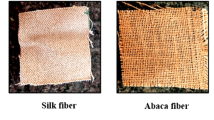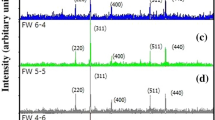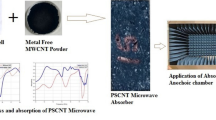Abstract
Electromagnetic pollution is a great concern in the present day. Activated carbon derived from waste sources can prove to be a green and cost-effective solution in this situation. In this work, a comparative study has been conducted to explore the potential of cowdung (animal waste)-derived activated carbon towards microwave absorption. Cowdung, which is abundantly available in the environment as a source of biomass, is used as the filler after being activated through two different routes, physical (carbonization) and chemical (acid and base activation). Due to the properties of being lightweight, flexible, corrosion resistive and having ease of large area fabrication, polydimethyl siloxane (PDMS) elastomer has been chosen as a matrix for the composites. Characterizations such as SEM, XRD and FTIR were performed to investigate the morphological and the functionalities present in the porous carbon structure. BET was further performed to investigate parameters such as specific surface area and pore volumes of the samples. Apart from the contribution from interfacial polarization owing to the dielectric properties of the filler material, the induced porosity resulted in hollow carbon structures which contributed to the microwave absorbing properties by scattering and reflecting the incident radiation. In the systems studied, the physically activated samples and the H2SO4-activated sample amongst chemical-activated samples are seen to reach values of ~ − 25 dB thickness as low as 4 mm. The best result is seen correspond to the composite carbonized at 600 °C, which shows ~ − 26 dB of microwave absorption with a bandwidths below − 10 dB (which corresponds to 90% absorption) ranging over 2 GHz. Hence these results indicate the suitability of these systems for real-time applications electronic system shielding.









Similar content being viewed by others
Data Availability
Not applicable.
Code availability
Not applicable.
References
D. Bhattacharjya, J.S. Yu, Activated carbon made from cow dung as electrode material for electrochemical double layer capacitor. J. Power Sources 262(15), 224–231 (2014)
H. Zhao et al., Biomass-derived porous carbon-based nanostructures for microwave absorption. Nano-Micro Lett. 11(1), 1–17 (2019)
Y. Du et al., “The electromagnetic properties and microwave absorption of mesoporous carbon,” Mater. Chem. Phys., 2012.
X.F. Zhang et al., Microwave absorption properties of the carbon-coated nickel nanocapsules. Appl. Phys. Lett. 89, 053115 (2006)
Z. Wu et al., Hierarchically porous carbons derived from biomasses with excellent microwave absorption performance. ACS Appl. Mater. Interfaces 10(13), 11108–11115 (2018)
S. Gao, G. Zhang, Y. Wang, X. Han, Y. Huang, P. Liu, MOFs derived magnetic porous carbon microspheres constructed by core-shell Ni@C with high-performance microwave absorption. J. Mater. Sci. Technol. 88, 56–65 (2021)
X. Jia et al., Synthesis of lightweight and flexible composite aerogel of mesoporous iron oxide threaded by carbon nanotubes for microwave absorption. J. Alloys Compd. 637, 138–146 (2017)
Y. Zhang et al., Composition and structure control of ultralight graphene foam for high-performance microwave absorption. Carbon 105, 438–447 (2016)
J. Pan et al., Porous coin-like Fe@MoS 2 composite with optimized impedance matching for efficient microwave absorption. Appl. Surf. Sci. 457, 271–279 (2018)
M. Ma et al., NiCo2O4 nanosheets decorated on one-dimensional ZnFe2O4@SiO2@C nanochains with high-performance microwave absorption. J. Colloid Interface Sci. 578, 58–68 (2020)
J. Lee, J. Kim, T. Hyeon, Recent progress in the synthesis of porous carbon materials. Adv. Mater. 18, 2073–2094 (2006)
P. Liu, S. Gao, G. Zhang, Y. Huang, W. You, R. Che, Hollow Engineering to Co@N-Doped Carbon Nanocages via Synergistic Protecting-Etching Strategy for Ultrahigh Microwave Absorption. Adv. Funct. Mater. 31, 2102812 (2021)
M. Cao et al., Graphene nanohybrids: Excellent electromagnetic properties for the absorbing and shielding of electromagnetic waves. J. Mater. Chem. C 6, 4586–4602 (2018)
T. Guan et al., Insight into controllability and predictability of pore structures in pitch-based activated carbons. Microporous Mesoporous Mater. 271, 118–127 (2018)
A. Dobashi, J. Maruyama, Y. Shen, M. Nandi, H. Uyama, Activated carbon monoliths derived from bacterial cellulose/polyacrylonitrile composite as new generation electrode materials in EDLC. Carbohydr. Polym. 200(July), 381–390 (2018)
J. Ding et al., Peanut shell hybrid sodium ion capacitor with extreme energy-power rivals lithium ion capacitors. Energy Environ. Sci. 5, 941–955 (2015)
X. Wu, L. Jiang, C. Long, Z. Fan, From flour to honeycomb-like carbon foam: Carbon makes room for high energy density supercapacitors. Nano Energy 537, 527–536 (2015)
J. Wang, S. Kaskel, KOH activation of carbon-based materials for energy storage. J. Mater. Chem. 22, 23710–23725 (2012)
H. Demiral, I. Demiral, Surface properties of activated carbon prepared from wastes. Surf. Interface Anal. 40, 612–615 (2008)
M. Olivares-Marín, C. Fernández-González, A. MacÍas-García, V. Gómez-Serrano, Preparation of activated carbon from cherry stones by physical activation in air. Influence of the chemical carbonisation with H2SO4. J. Anal. Appl. Pyrolysis 94, 131–137 (2012)
C. Wang, D. Ma, X. Bao, Transformation of biomass into porous graphitic carbon nanostructures by microwave irradiation. J. Phys. Chem. C 112(45), 17596–17602 (2008)
S. Sukarni, U. Yanuhar, N. Hamidi, and W. Wijayanti, “Combustion of microalgae Nannochloropsis oculata biomass: cellular macromolecular and mineralogical content changes during thermal decomposition Combustion of microalgae Nannochloropsis oculata biomass: cellular macromolecular and mineralogical content changes during thermal decomposition,” no. January, vol. 40 (6), pp. 1456–1463, 2019.
A. Avinash, A. Murugesan, Chemometric analysis of cow dung ash as an adsorbent for purifying biodiesel from waste cooking oil. Sci. Rep. 7, 9526 (2017)
C.R.P.G.H. Oh, Chang Hun Yun, “Role of KOH in the one-stage KOH activation of cellulosic biomass.” Carbon N. Y. 4, 180–184 (2003)
S.P. Pawar, M. Gandi, C. Saraf, S. Bose, Exceptional microwave absorption in soft polymeric nanocomposites facilitated by engineered nanostructures. J. Mater. Chem. C 4, 954–4966 (2016)
R.K. Jani, M.K. Patra, L. Saini, A. Shukla, C.P. Singh, S.R. Vadera, Tuning of microwave absorption properties and electromagnetic interference (EMI) shielding effectiveness of nanosize conducting black-silicone rubber composites over 8–18 GHz. Prog. Electromagn. Res. M 58, 198–204 (2017)
S.S. Kim, S.B. Jo, K.I. Gueon, K.K. Choi, J.M. Kim, K.S. Churn, Complex permeability and permittivity and microwave absorption of ferrite-rubber composite in X-band Frequencies. IEEE Trans. Magn. 27, 5462–5464 (1991)
J.E. Atwater, R.R. Wheeler, Microwave permittivity and dielectric relaxation of a high surface area activated carbon. Appl. Phys. A Mater. Sci. Process. 79, 125–129 (2004)
J.A. Menéndez et al., Microwave heating processes involving carbon materials. Fuel Process. Technol. 79, 125–129 (2010)
Y. Yang, C. Shi, Y. Zhang, J. Ye, H. Zhu, K. Huang, Characterizing adsorption performance of granular activated carbon with permittivity. Materials 10(3), 269 (2017)
B.G. Liu et al., Temperature rising characteristics of ammonium diurante in microwave fields. Nucl. Eng. Des. 240, 2710–2713 (2010)
L. Wang et al., The effect of ZnCl2 activation on microwave absorbing performance in walnut shell-derived nano-porous carbon. RSC Adv. 9, 9718–9728 (2019)
N. Wu, X. Liu, C. Zhao, C. Cui, A. Xia, Effects of particle size on the magnetic and microwave absorption properties of carbon-coated nickel nanocapsules. J. Alloys Compd. 657, 628–634 (2016)
J.Z. He, X.X. Wang, Y.L. Zhang, M.S. Cao, Small magnetic nanoparticles decorating reduced graphene oxides to tune the electromagnetic attenuation capacity. J. Mater. Chem. C 4, 7130–7140 (2016)
Acknowledgements
The authors would like to acknowledge ARDB grant ARDB/01/2031900/M/I and Prof. K. J. Vinoy, Department of ECE, Indian Institute of Science (IISc) for providing the VNA facility for measurements.
Funding
The authors would like to acknowledge ARDB grant ARDB/01/2031900/M/I for funding.
Author information
Authors and Affiliations
Contributions
Not applicable.
Corresponding author
Ethics declarations
Conflict of interest
There are no conflicts of interest to declare.
Ethical approval
Not applicable.
Consent to participate
Not applicable.
Consent for publication
Yes, we consent to publish.
Additional information
Publisher's Note
Springer Nature remains neutral with regard to jurisdictional claims in published maps and institutional affiliations.
Rights and permissions
About this article
Cite this article
Khasnabis, S., HS, M.J., Bora, P.J. et al. Comparative studies on physical and chemical routes for animal waste-derived activated carbon for microwave absorption in the X-band. J Mater Sci: Mater Electron 33, 3425–3437 (2022). https://doi.org/10.1007/s10854-021-07224-3
Received:
Accepted:
Published:
Issue Date:
DOI: https://doi.org/10.1007/s10854-021-07224-3




